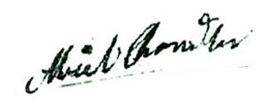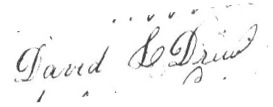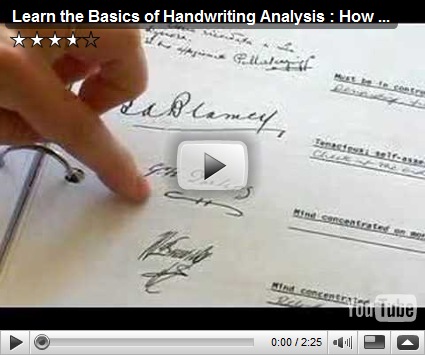After spending several nights trying to interpret the handwriting on old census records, I realized that I haven’t written anything extensive on paper for a long time.
How does my handwriting now compare to what it did when I was young? Well, it depends on the day. Some days, my current hand strokes produce very legible well-formed text. On other days, the message still leaves my brain but seems to degrade by the time it reaches my hand and my writing suffers as a result.
Of course, some days I’m apparently dyslexic when using a keyboard and some days it isn’t a problem. One thing is for sure though, the less I write by hand, the more the quality of my handwriting suffers.
I took a calligraphy class years ago and enjoyed learning how to apply artful strokes to build alphabetic characters. Unfortunately, that skill set has settled back into the primordial goo from lack of use.
 The handwriting of my ancestors has always fascinated me. I constantly look for any examples of it on old documents and am happy when I find their signature and ecstatic when I find a letter or more lengthy document that came from their hand.
The handwriting of my ancestors has always fascinated me. I constantly look for any examples of it on old documents and am happy when I find their signature and ecstatic when I find a letter or more lengthy document that came from their hand.
I’m using my great grandfathers letters as a base for the current series of postings on my lineagekeeper blog. The letters are treasure in my estimation. Not only do they convey his sometimes irascible humor, but they are windows into his personality, life, loves and concerns. His character, mannerisms and view of his fellow man would be lost without them. Grandpa and his family would be reduced to the basic statistics that are so common to family history researchers: Name, Dates, Places .. end of story.
If you’ve read my earlier notes, you know how much I love the old account books, family records on bible and remembrance pages and legal documents that were created by my ancestors. They are Treasure. Pure treasure.
The topic of handwr iting was on my mind when I found story on the BBC Magazine website titled “The Slow Death of Handwriting”. I couldn’t resist parroting its title for this note. The article posits that handwriting will soon be a thing of the past because we are all moving to computers to communicate, send cards, keep our financial records and historical documents.
iting was on my mind when I found story on the BBC Magazine website titled “The Slow Death of Handwriting”. I couldn’t resist parroting its title for this note. The article posits that handwriting will soon be a thing of the past because we are all moving to computers to communicate, send cards, keep our financial records and historical documents.
Shaking my head in dismay, I realized that the article describes me and probably you too. Unless we make a conscious effort to convey our handwritten words to paper, any extensive writing we do today is via our keyboard. That’s not to say that I still don’t burn through pens and stacks of note paper, but the ink I usually spread today is limited to brief notes, rows of record numbers from my genealogical database or telephone numbers. None of my longer notes are handwritten now.
I mourn its loss but truth is, other than my journal which I purposely record by hand, I probably won’t go back to doing much extensive handwriting. It is just too slow and my spelling errors don’t automatically correct themselves or at least tell me that I’m probably wrong.
How about you? Are you contributing to the mass extinction of the art? If not, how are you feeding its continued existence? Personally, I have written letters to my children that they will receive after I die. Hopefully the words and the letters themselves with be esteemed as treasure to them too.
If you have interest in learning more about handwriting and the personalities behind it, watch the video below and the associated videos on the same page. If you are a genealogist, the series of videos will serve you well in your ancestral quest.










2 comments:
I like the title of your article, only I am not so sure how slow the death is. For several years now I have become increasingly more aware of how little handwriting I see from the generations below me. It looks to me like it will continue to dwindle even faster as new technologies flood the markets.
I've been thinking seriously about talking to genealogy groups to interest them in learning more about their ancestors from their writings. I've been a handwriting analyst since the 70's and am becoming convinced that a major use of our skill in the future will be for those doing research of their ancestors writings. Glad to see that you are doing that.
I enjoyed reading your article. Thanks, JC in Colorado
This article is about HANDWRITING but nothing about PRINTING.
Many now print and it comes from the same brain. Printing is analyzable. There's still only two possible movements: straight and curved. Look around, that's all there is. Then size, pressure, speeed, form, spacing and the rest.
For a better understanding of handwriting and printing (reference only), read:
Handwriting Analysis: Laws/Principles...and More
So, we need to be talking as well about printing.
Jacob J. Cammarata, President, Handwriting Analysis Inc., Since 1977 and author of the book challenging with substance major concepts like knowing copybook, the standard size of the MZ (it's not 3 mm) shown in the 20-year study, and much more.
Post a Comment